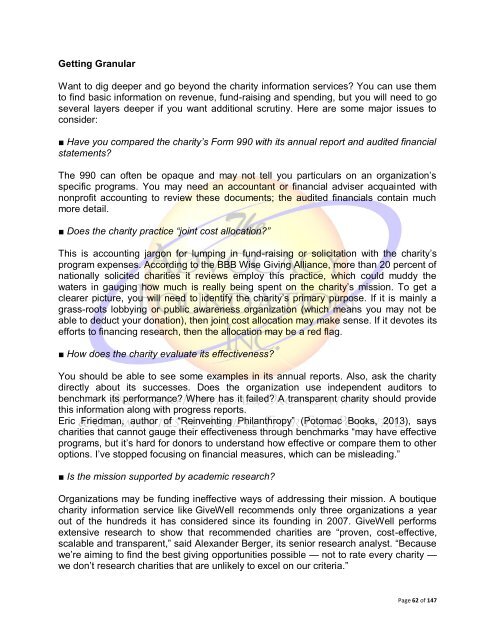Nonprofit Transparency
Nonprofit Transparency
Nonprofit Transparency
You also want an ePaper? Increase the reach of your titles
YUMPU automatically turns print PDFs into web optimized ePapers that Google loves.
Getting Granular<br />
Want to dig deeper and go beyond the charity information services? You can use them<br />
to find basic information on revenue, fund-raising and spending, but you will need to go<br />
several layers deeper if you want additional scrutiny. Here are some major issues to<br />
consider:<br />
■ Have you compared the charity’s Form 990 with its annual report and audited financial<br />
statements?<br />
The 990 can often be opaque and may not tell you particulars on an organization’s<br />
specific programs. You may need an accountant or financial adviser acquainted with<br />
nonprofit accounting to review these documents; the audited financials contain much<br />
more detail.<br />
■ Does the charity practice “joint cost allocation?”<br />
This is accounting jargon for lumping in fund-raising or solicitation with the charity’s<br />
program expenses. According to the BBB Wise Giving Alliance, more than 20 percent of<br />
nationally solicited charities it reviews employ this practice, which could muddy the<br />
waters in gauging how much is really being spent on the charity’s mission. To get a<br />
clearer picture, you will need to identify the charity’s primary purpose. If it is mainly a<br />
grass-roots lobbying or public awareness organization (which means you may not be<br />
able to deduct your donation), then joint cost allocation may make sense. If it devotes its<br />
efforts to financing research, then the allocation may be a red flag.<br />
■ How does the charity evaluate its effectiveness?<br />
You should be able to see some examples in its annual reports. Also, ask the charity<br />
directly about its successes. Does the organization use independent auditors to<br />
benchmark its performance? Where has it failed? A transparent charity should provide<br />
this information along with progress reports.<br />
Eric Friedman, author of “Reinventing Philanthropy” (Potomac Books, 2013), says<br />
charities that cannot gauge their effectiveness through benchmarks “may have effective<br />
programs, but it’s hard for donors to understand how effective or compare them to other<br />
options. I’ve stopped focusing on financial measures, which can be misleading.”<br />
■ Is the mission supported by academic research?<br />
Organizations may be funding ineffective ways of addressing their mission. A boutique<br />
charity information service like GiveWell recommends only three organizations a year<br />
out of the hundreds it has considered since its founding in 2007. GiveWell performs<br />
extensive research to show that recommended charities are “proven, cost-effective,<br />
scalable and transparent,” said Alexander Berger, its senior research analyst. “Because<br />
we’re aiming to find the best giving opportunities possible — not to rate every charity —<br />
we don’t research charities that are unlikely to excel on our criteria.”<br />
Page 62 of 147

















